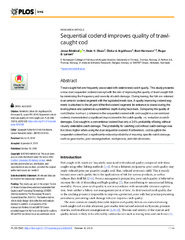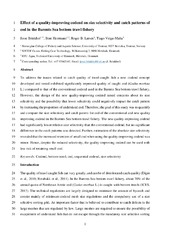| dc.contributor.advisor | Roger B., Larsen | |
| dc.contributor.author | Brinkhof, Jesse Vallevik | |
| dc.date.accessioned | 2019-01-30T13:51:00Z | |
| dc.date.available | 2019-01-30T13:51:00Z | |
| dc.date.issued | 2019-02-15 | |
| dc.description.abstract | This study focused on two important issues on the Barents Sea bottom trawl fishery for Northeast Arctic cod (Gadus morhua L.); catch quality (i.e., the quality of the fish caught) and size selectivity. The high abundance of cod encountered in recent years in the Barents Sea, leading to subsequent large annual quotas, has led to increased interest in improving the quality of fish caught by trawls. This increasing interest in improving the quality of fish caught by trawls has also been driven by the increasing demands from the industry, retailers, and consumers for traceable high-quality products, as well as fish welfare. Although catch efficiency and size selectivity have been the major aspects of the bottom trawl fishery for decades, the focus on catch quality and how the quality of the catch is affected by the fishing process has remained limited. To ensure a sustainable fishery, in terms of ecological, societal, and economical sustainability, both catch quality and size selectivity are the two important factors that must be considered. In many cases, these two factors are interlinked, as a given change in a trawling procedure or trawl gear component with the aim of improving catch quality might simultaneously influence size selectivity. Therefore, in this thesis, I investigate the effect of a trawling practice (Paper I and II) and trawl codend design (Paper III and IV) on catch quality (Paper I and III) and size selectivity (Paper II and IV).
The first part of my thesis (Paper I and II) presents a trawling practice, called buffer towing. It is claimed that this practice has a negative effect on both catch quality and size selectivity. Trawlers commonly re-deploy (“shoot”) the trawl directly after hauling a catch onboard. However, the approximate desired amount of fish is often caught before the catch from the previous haul has been processed. This issue frequently results in buffer towing, which entails lifting the trawl from the seabed and towing the catch midwater at low velocity until the onboard processing capacity is restored. Applying a new method for analyzing data derived from the assessment of catch quality demonstrated that buffer towing had a significant negative impact on the quality of the catch (Paper I). Furthermore, by applying a structural catch comparison method, Paper II demonstrated that, in addition to having a negative impact on catch quality, buffer towing negatively impacts size selectivity.
The first part of this thesis presents the effect of a trawl operation, while the second part presents the effect of gear design on the quality of the catch and size selectivity. This part presents a new codend concept, termed “dual sequential codend”. This codend was designed to improve the quality of cod and was specifically investigated in Paper III. However, due to the design of the codend, there were concerns that it would compromise size selectivity, which was investigated in Paper IV. The results demonstrated that the new codend concept significantly improved the quality of cod (i.e., reduced the damages incurred during the catch process compared to a conventional codend). Specifically, five times more flawless cod (i.e., no damage incurred during capture) was obtained using the new codend compared to the conventional codend. Investigation of size selectivity (Paper IV) indicated that the new codend concept led to a minor increase in the retention of small cod. Hence, as argued, improved catch quality by applying the sequential codend concept should be regarded as more important than the minor increase in the retention of small cod, both from the industry and management perspectives. | en_US |
| dc.description.doctoraltype | ph.d. | en_US |
| dc.description.popularabstract | This thesis describes the current challenges of catch quality and size selectivity in the Barents Sea bottom trawl fishery. The first part discloses a trawling practice (buffer towing), and its effect on the catch quality and size selectivity. Applying robust statistical methods, the results demonstrated a significant negative effect on both catch quality and size selectivity. The second part discloses a new trawl codend concept, which was designed to improve the catch quality without compromising size selectivity. The results from trails at sea demonstrated that the codend significantly improved the quality of trawl caught cod, with a minor increase in the retention of small fish. The thesis demonstrates the importance of evaluating the effect on both catch quality, and size selectivity when altering components of the trawl gear or the operational practice during bottom trawling. | en_US |
| dc.description.sponsorship | NFR, Grant No. 203477 | en_US |
| dc.identifier.isbn | 978-82-8266-164-5 | |
| dc.identifier.uri | https://hdl.handle.net/10037/14563 | |
| dc.language.iso | eng | en_US |
| dc.publisher | UiT The Arctic University of Norway | en_US |
| dc.publisher | UiT Norges arktiske universitet | en_US |
| dc.relation.haspart | <p>Paper I: Brinkhof, J., Larsen, R.B., Herrmann, B. & Olsen, S.H. (2018). Assessing the impact of buffer towing on the quality of Northeast Atlantic cod (<i>Gadus morhua</i>) caught with a bottom trawl. <i>Fisheries Research, 206</i>, 209-219. The paper is available in the thesis introduction. Also available at <a href=https://doi.org/10.1016/j.fishres.2018.05.021>https://doi.org/10.1016/j.fishres.2018.05.021. </a> <p>
<p>Paper II: Brinkhof, J., Herrmann, B., Larsen, R.B. & Sistiaga, M. (2018). Escape rate for cod (Gadus morhua) from the codend during buffer towing. <i>ICES Journal of Marine Science, 75</i>(2), 805-813. The paper is not available in Munin due to publisher restrictions. Available at <a href=https://doi.org/10.1093/icesjms/fsx200>https://doi.org/10.1093/icesjms/fsx200. </a> <p>
<p>Paper III: Brinkhof, J., Olsen, S.H., Ingólfsson, Ó., Herrmann, B. & Larsen R.B. (2018). Sequential codend improves quality of trawl-caught cod. <i>PLoS ONE, 13</i>(10): e0204328. Also available at <a href=https://doi.org/10.1371/journal.pone.0204328>https://doi.org/10.1371/journal.pone.0204328. </a><p>
<p>Paper IV: Brinkhof, J., Herrmann, B., Larsen, R.B. & Veiga-Malta, T. (2018). Effect of a quality-improving codend on size selectivity and catch patterns of cod in the Barents Sea bottom trawl fishery. (Submitted manuscript).<p> | en_US |
| dc.rights.accessRights | openAccess | en_US |
| dc.rights.holder | Copyright 2019 The Author(s) | |
| dc.rights.uri | https://creativecommons.org/licenses/by-nc-sa/3.0 | en_US |
| dc.rights | Attribution-NonCommercial-ShareAlike 3.0 Unported (CC BY-NC-SA 3.0) | en_US |
| dc.subject | VDP::Landbruks- og Fiskerifag. 900::Fiskerifag: 920::Fiskeriteknologi: 924 | en_US |
| dc.subject | VDP::Agriculture and fishery disciplines: 900::Fisheries science: 920::Fisheries technology: 924 | en_US |
| dc.title | Catch quality and size selectivity in the Barents Sea bottom trawl fishery: effect of codend design and trawling practice | en_US |
| dc.type | Doctoral thesis | en_US |
| dc.type | Doktorgradsavhandling | en_US |


 English
English norsk
norsk


